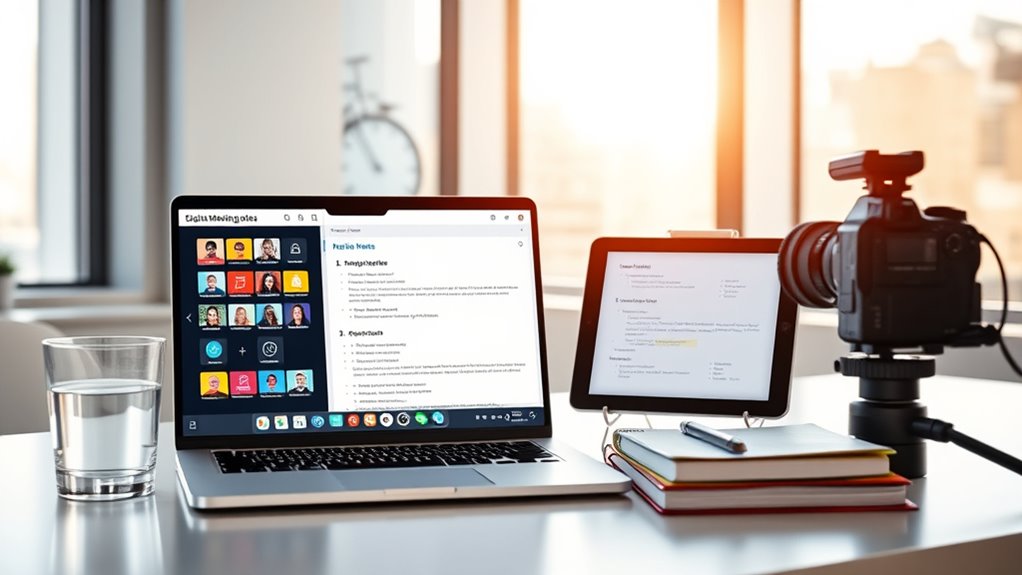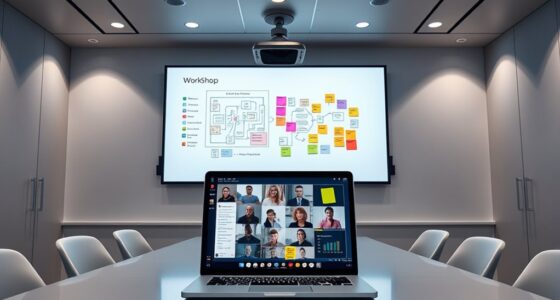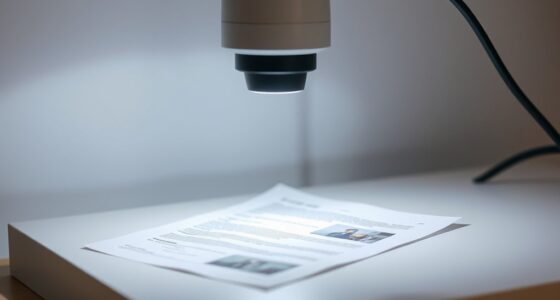To effectively document remote meetings, prepare notes beforehand using templates and note-taking apps to capture key decisions, action items, and deadlines. During the meeting, stay attentive, using platform features like recordings or transcriptions to reinforce your notes. Afterward, review and clarify points, then share clear summaries with your team while tracking tasks and deadlines. For detailed strategies on streamlining your process, explore the full guide to enhance your remote documentation skills.
Key Takeaways
- Prepare a structured template to capture decisions, actions, and deadlines efficiently during the meeting.
- Use recording and transcription features to supplement note-taking and ensure accuracy.
- Focus on key points and decisions instead of verbatim notes to stay engaged and efficient.
- Review and clarify notes promptly after the meeting to confirm understanding and follow-up actions.
- Share summarized notes immediately, encouraging feedback and collaboration for transparency and accountability.

Have you ever struggled to keep track of what was discussed during a remote meeting? If so, you’re not alone. Virtual settings can make it harder to remember key details, especially when juggling multiple conversations or dealing with technical glitches. To stay organized and guarantee nothing slips through the cracks, adopting effective note-taking strategies is essential. Start by preparing a dedicated document or digital note-taking app before the meeting begins. Use bullet points, headings, and abbreviations to capture information efficiently. Focus on recording decisions, action items, deadlines, and responsible parties rather than trying to transcribe everything verbatim. This approach helps you stay engaged and guarantees your notes are actionable afterward.
Effective remote meeting notes focus on decisions, action items, and deadlines for better organization and follow-through.
Once the meeting ends, follow-up procedures become vital for maintaining momentum. Review your notes promptly while the discussion is fresh in your mind. Clarify any ambiguous points by reaching out to colleagues or the meeting host if needed. This proactive step prevents misunderstandings and guarantees everyone is aligned on next steps. Incorporate a clear process for tracking action items, such as assigning tasks with deadlines and marking completed items. Using project management tools or shared checklists can streamline this process, making it easier to hold everyone accountable. Regularly update your notes and follow up on outstanding tasks to keep projects moving forward. This habit not only keeps you organized but also demonstrates your commitment to follow-through.
Another effective note-taking strategy involves leveraging technology. Many remote meetings are hosted on platforms that support recording or transcription features. If available, record meetings or enable transcription to revisit details later. However, don’t rely solely on recordings; actively taking notes during the meeting helps you stay attentive and reinforces your understanding. Consider using templates tailored for meetings—templates that prompt you to capture key points, decisions, and follow-up actions. This consistency saves time and improves accuracy over repeated sessions. Additionally, being mindful of your mental clarity can enhance your ability to absorb and process information during the meeting.
Finally, sharing your notes with all participants can enhance transparency and accountability. Distribute a summarized version highlighting decisions and assigned tasks soon after the meeting. Encourage others to add comments or correct inaccuracies, fostering collaborative documentation. By combining effective note-taking strategies with disciplined follow-up procedures, you create a reliable record of your remote meetings. This not only improves individual productivity but also ensures your team stays aligned, making remote collaboration seamless and efficient.
Frequently Asked Questions
How Do I Ensure Remote Meeting Security and Confidentiality?
To guarantee remote meeting security and confidentiality, you should implement strong access controls, like password protection and user authentication. Use encryption protocols to secure data transmission, preventing unauthorized access or eavesdropping. Always verify participants’ identities before granting access, and avoid sharing meeting links publicly. Regularly update your software and security settings, and remind participants to keep their devices secure, making sure your remote meetings stay private and protected.
What Tools Are Best for Real-Time Meeting Note Collaboration?
Did you know 78% of teams find collaborative editing vital for productivity? For real-time meeting note collaboration, tools like Google Docs and Microsoft OneNote are excellent choices. They offer seamless real-time syncing, enabling everyone to contribute simultaneously. These platforms make collaborative editing simple, eliminate version confusion, and guarantee your notes are always up-to-date. By choosing these tools, you’ll boost efficiency and keep everyone on the same page during remote meetings.
How Can I Make Remote Meeting Notes Accessible to All Team Members?
You can make remote meeting notes accessible to all team members by using digital note sharing platforms like Google Docs or SharePoint. Guarantee your documentation is organized and stored in a centralized location, making it easy for everyone to access and update. Regularly share links and updates through your team communication channels, and encourage feedback to keep the accessible documentation current and useful for all team members.
What Are Effective Strategies for Summarizing Complex Discussions?
You can effectively summarize complex discussions by using visualization techniques like mind maps or charts to capture key points visually. Combine this with structured summarization, breaking down information into clear sections such as main ideas, supporting details, and action items. This approach makes it easier to understand and recall discussions, ensuring all team members grasp intricate topics quickly and accurately.
How Should I Handle Follow-Up Actions From Remote Meetings?
Remember, a stitch in time saves nine. After a remote meeting, you should promptly assign clear action items and set deadlines to make certain follow-up accountability. Use action item tracking tools to organize and monitor progress. Regularly check in on these tasks, and communicate updates to keep everyone on the same page. This proactive approach helps prevent overlooked responsibilities and keeps projects moving smoothly.
Conclusion
By now, you see how effective remote meeting documentation can transform your team’s productivity. When you keep clear, organized notes, you guarantee everyone stays on the same page and follow-ups happen smoothly. Isn’t it worth investing a little effort now to save headaches later? So, why not start implementing these best practices today and watch your remote meetings become more efficient and impactful? Your team will thank you for it!









